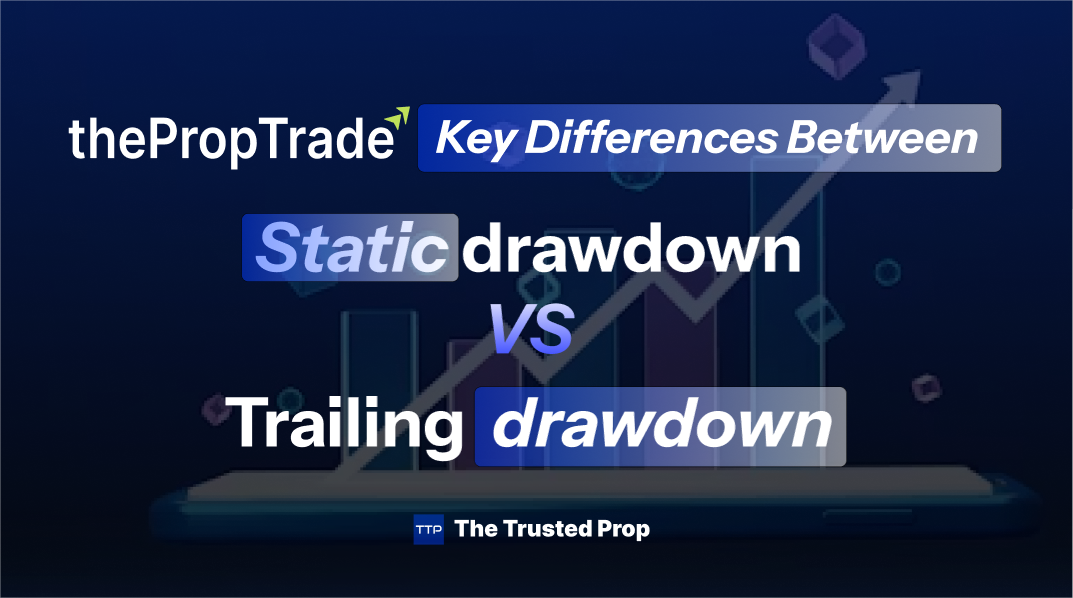Copy Coupon Code to Get
20% Off 🎉

thePropTrade
Forex, Metals, oil, Indices, Crypto
AE
2024
CEO: KATARINA KVASNICAK
Coupon Code:
Trade Locker
Crypto
Crypto
Wire transfer/ Bank Transfer
Credit/Debit Card
Mpesa
Mobile Money(Africa)
TradeLocker
Static vs Trailing Drawdown 2025 – thePropTrade Rules Explained | The Trusted Prop

Static vs Trailing Drawdown 2025 – thePropTrade Rules Explained | The Trusted Prop
6/19/2025
Introduction

Honestly in prop trading, it is not just about making money. It is also about not losing too much. That is where drawdowns come in.
Every funded trader has to respect these rules. If you don’t understand how drawdowns work, you could blow your account without even realizing it. And trust us it happens more often than you’d think.
This article is here to help you understand the difference between static and trailing drawdown, especially as used by thePropTrade. We will keep it real, simple, and to the point.
What is a Drawdown?
A drawdown is basically the maximum amount your account can go down before you are disqualified.
Think of it like a “danger zone.” Go past it? You are out.
Still confused? Picture a roller coaster:
Your account goes up, then down, then up again. That “dip” from the highest point to the lowest is your drawdown. In prop trading, firms put rules in place to limit how deep that dip can be.
Managing drawdowns protects both the trader and the firm. And each prop firm does it a little differently that is why knowing how your prop firm calculates it matters.
What is Static Drawdown
A static drawdown is simple: it is fixed from the moment you start trading.
At thePropTrade, the Maximum Overall Drawdown is static. That means once it is set, it never moves no matter how well your account performs.
Example:
Let us say you start with a $100,000 account.
Your max drawdown is set at 10%. That means:
- Your hard stop is $90,000.
- Even if you grow your balance to $110,000 or more, the drawdown limit stays at $90,000.
So if your account equity ever drops below $90,000, even after making $5K or $10K in profits, your account gets disqualified.
Pros:
- Super easy to calculate
- Doesn’t move around or require daily checks
- Gives a solid safety net upfront
Cons:
- Does not increase with your profits
- You don’t get extra breathing room even if you are doing well
What is Trailing Drawdown?
Now let us talk about trailing drawdown, which is a bit more active.
A trailing drawdown adjusts based on your daily performance. The more your balance grows, the more room you have but it can also be stricter to manage.
At thePropTrade, this logic is used for your Maximum Daily Drawdown and it is balance-based and recalculates daily at 17:00 EST.
Example:
- Yesterday’s balance: $101,500
- Daily Drawdown: 5%
- 5% of 101,500 = $5,075
That means today, you can’t lose more than $5,075 including closed trades and floating losses.
If you go past that, even for a minute? Your account is done. And tomorrow, the drawdown resets again at 5% of the new balance. That is how it “trails” your performance always keeping up with your latest progress.
Pros:
- Adjusts upward as you grow
- Encourages stable, profitable trading
- Gives more room if you’re doing well
Cons:
- You need to check it every single day
- Riskier if you don’t track floating losses
- A sharp loss after a big win can cost you the account
Key Differences Between Static and Trailing Drawdowns

| Feature | Static Drawdown | Trailing (Daily) Drawdown |
|---|---|---|
| Moves with profits | ❌ No | ✅ Yes (Daily balance-based) |
| Used for overall Drawdown | ✅ Yes | ❌ No |
| Recalculates daily | ❌ Fixed from Day 1 | ✅ Recalculates daily at 17:00 EST |
| Easiest to track | ✅ Simple math | ❌ Needs daily monitoring |
| Covers open trades | ❌ Only closed trades count | ✅ Includes floating losses |
| Good for | Long-term and conservative traders | Active traders with good risk control |
Practical Implications for Traders in 2025
Understanding how drawdowns work can be the difference between getting funded and getting disqualified.
Prop firms like thePropTrade now combine both static and trailing logic:
- Static Drawdown keeps you grounded and gives you a clear loss limit
- Daily Trailing Drawdown ensures you're not reckless on any one day
Tips for Traders:
- Always check your previous day’s balance before trading
- Know your daily loss limit including floating losses
- Use a spreadsheet or tool to monitor DD each morning
- Trade smaller when close to your drawdown no revenge trading!
Visual Comparison & Examples
| Scenario | Static Drawdown | Trailing (Daily) Drawdown |
|---|---|---|
| Starting Balance | $100,000 | $101,500 (Day 2) |
| Drawdown % | 10% | 5% |
| Max Loss Limit | $90,000 (never moves) | $5,075 for the current day |
| Profit Made (Day 1) | +$1,500 | New balance = $101,500 |
| Next Day Risk | Still $90K min equity | Must stay above $96,425 |
Thinking of signing up for thePropTrade challenge? Don’t pay full price. Use our verified discount code to get 20% off instantly no schemes, no expired codes. Whether you are going for the Express (1-phase), Standard (2-phase), or Pro challenge, this code works across all account sizes. That means more savings before you even place your first trade.

Bonus Perks? Yep:
- You can also earn cashback,
- Or get TradeSync access,
- Or collect Trust Points you can redeem later.
So if you are starting a new challenge at thePropTrade, do it smart and do it cheaper with The Trusted Prop.
Conclusion
So, to sum it up:
- Static Drawdown = One fixed limit. Easy to understand, doesn’t adjust.
- Trailing Drawdown = Changes daily, based on your balance. More flexible, but riskier if unmanaged.
At thePropTrade, you will face both:
- A static 10% overall drawdown
- A 5% trailing daily drawdown, updated daily at 5 PM EST
Understand both. Track both. Trade within both.
If you are serious about getting funded and staying funded know your drawdowns before you even take your first trade.
Got questions? Visit The Trusted Prop for more guides, tools, and trader tested insights.
Check out thePropTrade full review on The Trusted Prop, to get started smarter.
You may also like
Top One Trader Detailed Review 2025 (Honest Breakdown)

DNA Funded Funding Types, Fees, Rules & Payouts (2025)

Top One Trader Rules (2025): EAs, News, Copy Trading & More
.jpeg&w=1920&q=75)
ATFunded Trading Rules: Drawdown, News Trading and More
.jpeg&w=1920&q=75)
ATFunded Detailed Review 2025: Challenges, Rules, Payouts & Real Trader Insights

Top One Trader Payout Rules & Profit Split Guide (2025)
.jpeg&w=1920&q=75)
iFunds Account Types, Fees, Rules & Payouts (2025)

No FAQs are available for this topic yet.